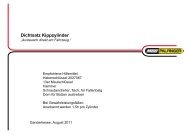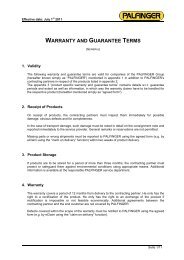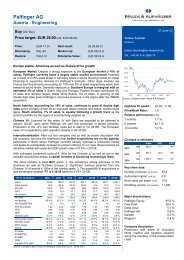palfinger at a glance
palfinger at a glance
palfinger at a glance
Create successful ePaper yourself
Turn your PDF publications into a flip-book with our unique Google optimized e-Paper software.
noteS TO THE CONSolid<strong>at</strong>ed FINANCIAL St<strong>at</strong>ementS<br />
conSolid<strong>at</strong>ed FINANCIAL St<strong>at</strong>ementS FOR THE Year ENDED 31 DECEMBER 2011<br />
> search Print<br />
(5) CONTRACT MANUFACTURING<br />
Receivables from projects and sales in this connection are recognized in accordance with the percentage of<br />
completion. Projects are characterized by the fact th<strong>at</strong> they are agreed on the basis of individual contractual terms<br />
with fixed prices. The percentage of completion is determined by means of the cost-to-cost method. Reliable<br />
estim<strong>at</strong>es of the total costs of the contracts, the selling prices and the actual costs incurred are available on a<br />
monthly basis. The estim<strong>at</strong>ed profits from the contracts are realized in proportion to calcul<strong>at</strong>ed sales. When<br />
applying the cost-to-cost method, sales and contract revenue are recognized in proportion of the manufacturing<br />
costs actually incurred to the expected total costs. Losses are booked through the income st<strong>at</strong>ement as soon as<br />
they are identified. For technological and financial risks th<strong>at</strong> might occur during the remaining term of the project,<br />
an individual estim<strong>at</strong>e is made for each contract and the corresponding amounts are reported in estim<strong>at</strong>ed total<br />
costs. Imminent losses resulting from the measurement of projects not yet invoiced are immedi<strong>at</strong>ely recorded as<br />
expenses. Imminent losses are realized if total contract costs are likely to exceed the contract revenue.<br />
(6) FINANCIAL INStrumentS<br />
Financial assets within the meaning of IAS 39 are classified either as held for trading, loans and receivables,<br />
available for sale or hedging deriv<strong>at</strong>ives. PALFINGER determines the design<strong>at</strong>ion of its financial assets upon initial<br />
recognition.<br />
When they are recognized initially, financial assets are measured <strong>at</strong> fair value. In the case of financial investments<br />
th<strong>at</strong> are not recognized <strong>at</strong> fair value through the income st<strong>at</strong>ement, transaction costs are recognized as well.<br />
These costs are directly allocable to the acquisition of the assets.<br />
Acquisitions or sales of financial assets are recognized <strong>at</strong> the trade d<strong>at</strong>e.<br />
The fair value of financial instruments is the amount for which a financial instrument could be exchanged<br />
between knowledgeable, willing and independent parties in an arm’s length transaction. The fair value is<br />
frequently identical to the market price, and therefore its calcul<strong>at</strong>ion is based on market inform<strong>at</strong>ion available <strong>at</strong><br />
the balance sheet d<strong>at</strong>e. The values listed may diverge from values realized l<strong>at</strong>er due to varying determinants.<br />
Market values are available for all deriv<strong>at</strong>ive financial instruments and securities. The fair values for all other<br />
financial instruments are determined on the basis of the discounted anticip<strong>at</strong>ed cash flows.<br />
Securities and other shareholdings<br />
Securities and other shareholdings are classified as available for sale according to IAS 39. They are measured <strong>at</strong> fair<br />
value provided th<strong>at</strong> a reliable fair value can be determined. Significant unrealized profits and losses are recognized in<br />
equity. In the case of sales, the unrealized profit and/or loss th<strong>at</strong> up to th<strong>at</strong> point had been reported in the balance<br />
sheet will be reported in the income st<strong>at</strong>ement under other financial expenses. Impairment losses are recorded in<br />
the income st<strong>at</strong>ement. Impairment losses recorded for equity instruments are reversed in the balance sheet,<br />
impairment losses recorded for debt instruments in the income st<strong>at</strong>ement.<br />
Loans<br />
Interest-bearing loans are classified as loans and receivables according to IAS 39. To the extent th<strong>at</strong> no impairment<br />
losses are required, they are reported <strong>at</strong> amortized cost, applying the effective interest method, and less any<br />
impairment losses; non-interest bearing loans and interest-bearing loans with low r<strong>at</strong>es of interest are discounted<br />
accordingly. Impairment losses are reversed through the income st<strong>at</strong>ement.<br />
126<br />
<strong>palfinger</strong> Annual Report 2011

















